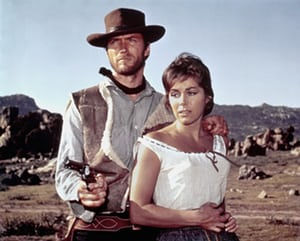DVD Review: Kino releases a new master of A Fistful of Dollars
- James L. Neibaur
- May 24, 2018
- 3 min read
Kino Lorber has offered a new blu ray release of “A Fistful of Dollars,” Sergio Leone’s first “Spaghetti Western” featuring Clint Eastwood as the ominous presence who rides into town and is often referred to as “the man with no name” (he is called Joe in this movie).

Clint Eastwood was not Sergio Leone's first choice. The director wanted to go against Hollywood western convention by casting Henry Fonda in the role, but this level of movie star was too expensive for the low budget production. Leone also considered western actor Rory Calhoun and then Charles Bronson, but both turned it down. Clint Eastwood later recalled: “I got the part because I was cheap.” Eastwood was a noted TV western star on the network program “Rawhide” and had played small parts in movies since the 1950s, so he had, at least, a marginal name.

When Eastwood first read the script, he recognized it as having been inspired by Akira Kurosawa's Japanese samurai film Yojimbo (1961). Eastwood recalled for Playboy in 1974: “The funny thing was that this buddy and I had seen Yojimbo together, and at the time we were both impressed by what a good Western it
would make—the way The Magnificent Seven was made from Seven Samurai. But we thought it wouldn't sell; it would be too rough. I had a hunch that if it was handled well, it'd work. I was tired of playing the nice clean-cut cowboy in “Rawhide;” I wanted something earthier, something different from the old-fashioned western.”
While it challenges the western cinema's clichés, and is inspired by a Japanese samurai film, there still remains some elements of convention in Leone's narrative. Eastwood's character rides into town as a stranger, cleans up the corruption, saves the townsfolk, bids his farewell, and rides out of town. However, it is the filmmaker's presentation of this classic structure, with heightened violence, editing, use of close-ups, and, certainly, Clint Eastwood’s approach to the central character, that separate it from the ordinary.
Also, Ennio Morricone's score further enhances each scene. Rather than the sweeping orchestral backgrounds of most American westerns, the scenes in this film were backed by a more distinctive sound. Instead of instruments from a full orchestra, Morricone utilized such offbeat sounds as gunshots, cracking whips, whistles, chanting voices, and a Fender electric guitar.
“A Fistful of Dollars” first became popular in Europe, but was not initially released in the states. Its North American premiere happened in Canada in 1966, a full two years after its European release. Because of the diversity of languages spoken in the film, A Fistful of Dollars was shot silent, with dialog looped in later, but Clint Eastwood did not add his own voice to the soundtrack until the film was released in the United States in 1967.

When the film finally opened in the United States in early 1967, Clint Eastwood had finished his run on Rawhide, and had completed two more films for Leone (“For a Few Dollars More” and “The Good, The Bad, and The Ugly”). This trilogy that made Clint Eastwood a worldwide star, allowed Sergio Leone to emerge as a director of style and vision, and breathed new life into a dying film genre with a more progressive presentation. And, finally, it has withstood the test of time.
Kino Lorber’s release is a brand new 4K restoration. Special features include commentary by film historians Tim Lucas and Sir Christopher Frayling and actress Marianne Koch. Also included are outtakes, an image gallery (including an animated image gallery), and footage from Sir Christopher’s archives including Eastwood’s recollections of making the film, The TV prologue with Harry Dean Stanton, Monte Hellman discussing his part in creating that prologue, and then-and-now location comparisons. It is one of the most impressive packages of special features found on any DVD release.
It is highly recommended to upgrade your copy of “A Fistful of Dollars” with this superior blu ray. It is certainly a must for libraries, research centers, and any private collection. One of cinema’s most important releases.
It is available here.
Comments